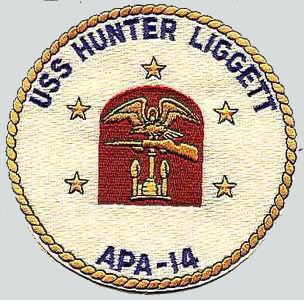Click On Image
For Full Size Image |
Size |
Image Description |
Contributed
By |
 USAT Hunter Liggett USAT Hunter Liggett
|
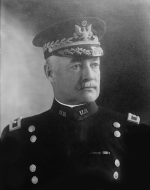 |
122k |
Namesake
Hunter Liggett was born in Reading, Pennsylvania, on March 21, 1857. In 1879 he graduated from West Point and was assigned as a second lieutenant in the Fifth Infantry.
He served in the Montana Territory, Dakota Territory, Texas and Florida, advancing to first lieutenant in June 1884. On 19 October 1894, 1LT Liggett arrived at Fort
McPherson along with the regimental headquarters of the 5th Infantry. He served as the Post Adjutant until 25 April 1896 at which time he took command of Company D,
5th Infantry. He was promoted to Captain in June 1897 and left the post when the entire 5th Infantry departed for the Spanish-American War. In June 1898 he was promoted
to Major and adjutant general of volunteers for service in Cuba, and the following year was sent to the Philippines with the 31st Infantry Volunteers. In June 1901 he
was mustered out of volunteer service and was promoted to major of regulars in May 1902 and lieutenant colonel in June 1909. Following Army War College graduation in
1910, he became president of the War College. The next year he took command of the 4th Brigade, 2nd Division at Texas City, Texas. He returned to the Philippines in
1916 in command of the Provisional Infantry Brigade and of Fort William McKinley. He served as commander of the Department of the Philippines from April 1916 to April
1917 when he was named commander of the Western Department in San Francisco. In August 1917 he took command of the 41st Division at Camp Fremont (Calif.) and deployed
with the unit to France. When General Pershing ordered that the first American army corps be formed in January 1918, he placed General Liggett in command. The corps
participated in the battles of Cantigny and Belleau Woods, as well as in the defense and offensive operations of the second Marne campaign in July and August. In
October 1918 General Pershing relinquished to Lt. Gen. Liggett command of the First Army with its one million soldiers. He remained in command of the First Army until
its inactivation in April 1919 when he moved to command the Third Army in occupation duty. Among his many decorations, General Liggett received the Distinguished Service Medal "For exceptionally meritorious and distinguished services as commander of the 1st army of the American expeditionary forces. He commanded the 1st corps and perfected its organization under difficult conditions of early service in France, engaged in active operations in reduction of the Marne salient and of the St. Mihiel salient, and participated in the actions of the forest of Argonne. He was in command of the 1st army when the German resistance was shattered west of the Meuse." Upon his return to the United States he commanded the IX Corps area headquartered in San Francisco. General Liggett retired in March 1921 and in June 1930 was promoted to lieutenant general on the retired list by act of Congress. LTG Liggett died in San Francisco on December 30, 1935. Fort Hunter Liggett was named after Lt. Gen. Hunter Liggett (1857-1935), who served as General Pershing's chief of staff as well as the commanding general of First Army and Third Army. The post was originally designated Hunter Liggett Military Reservation in 1941. It consists of approximately 165,000 acres and lies about 22 miles southwest of King City and about 70 miles south of the Presidio of Monterey and the Naval Post Graduate School. It consists of varied terrain that ranges from level valleys and gentle hills, to steep, Rocky Mountains. Its mission is to provide areas for maneuvers, live firing of small arms and armor, fitness and survival training, and training for the Army Reserve. Fort Hunter Liggett was originally the summer ranch of William Randolph Hearst. Some of the buildings currently being used by the Garrison are from the original Hearst Milpitas Ranch. The Hacienda currently on the National Register of Historic Places serves as the Guesthouse and the Community Club. Also located on the fort is the La Cueva Pintada (The Painted Cave). The site also contains a number of original Indian paintings and other significant historical items. The USS Hunter Liggett (APA-14) was one of the three largest attack transports in the Amphibian Force during World War II. It carried 35 landing boats and 2 tank lighters, along with 51 officers and a crew of 634. It was operated by the U.S. Coast Guard.
Digital ID: ggbain 16581 Source: Library of Congress Prints and Photographs Division |
Bill Gonyo |
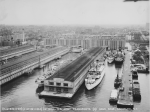
100301433
NAID 68145029 |
2403k |
Army Base, Brooklyn, 27 May 1939: USAT Republic (left foreground)
with an unidentified Army transport ahead of her;
USAT Hunter Leggett (right, nearest camera); and possibly
USAT Chateau Thierry (middle, background) moored alongside the Munson Steamship Line’s SS
Western World undergoing conversion to USAT Leonard Wood.
US Amry photo from the US National Archives and Records Administration Identified: NAID: 68145029 Local ID: 18-AA-85-25 and NAID: 68145031 Local ID: 18-AA-85-2 |
Theodore Leverett |
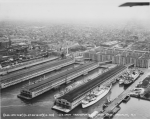
100301434
NAID 68145031 |
3468k |
 |
107k |
USAT Hunter Liggett underway, date and place unknown. |
Richard Leonhardt |

100301432 |
290k |
Post card image of USAT Hunter Liggett transiting the Panama Canal (postmarked 1940). |
David Wright |
 |
54k |
USAT Hunter Liggett, at Panama, circa 1939-40 |
M/Sgt. M.L. McCormick, USAF Ret |
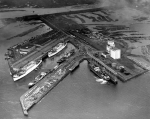 |
386k |
Views of the Port Pier at Tacoma, WA., 13 January 1940. USAT Hunter Liggett moored astern of
USAT Leonard Wood are transporting 7,500 soldiers from Fort Lewis and with the
USAT St. Mihiel, will transport the soldiers to war games being held 15-22 January,
1940 some where on the California coastline between San Francisco and Santa Barbara. The departure of these troops will leave Fort Lewis manned by only a small security
force.
Tacoma Public Library, Richards Studios, Photo #'s D9334-5 and D9334-13. Items in this collection are made available for educational, academic and personal use |
Mike Green |
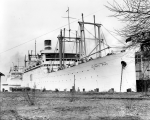 |
378k |
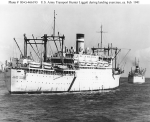 |
100k |
USAT Hunter Liggett, circa 3 February 1941, while taking part in fleet landing exercises in the Caribbean. Note Higgins-type landing craft on her deck, just aft of the midships superstructure, and U.S. flag painted on her hull side as a neutrality marking.
US National Archives photo # 80-G-466193, a US Navy photo, now in the collections of the US National Archives. |
uS Naval History and Heritage Command |
 |
483k |
USAT Hunter Liggett underway, date and location unknown. The Army operated Hunter Liggett for two years before she transferred to the Navy on 27 May 1942. During her Army time she participated in several amphibious exercises that demonstrated how ill-prepared both services were to effect over-the-beach landings.
US. Army Military History Institute photo from "U.S. Army Ships and Watercraft of World War II", by Donald H. Grover |
Robert Hurst |
 |
93k |
USAT Hunter Liggett moored pierside, date and location unknown. |
Tommy Trampp |
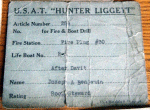 |
238k |
USAT Hunter Liggett crew fire and boat drill station assignments card |
Tommy Trampp |
 USS Hunter Liggett (AP-27) USS Hunter Liggett (AP-27)
|
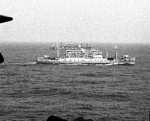
100300522 |
76k |
USS Barnett (AP-11) at a distance in a formation of troop transports as TF38 between 10 and 18 April, 1942. This was the earliest large force
departing the Tidewater and New York areas bound for Australia and Southwest Pacific. At extreme distance is
USS Hunter Liggett (AP27)
Photos by Frank Scherschel, Life Magazine, aboard USS Texas (B-35). Used for non-commercial and educational purpose. |
John Chiquoine |
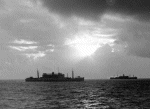
100300523 |
97k |
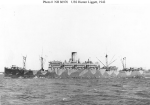 |
62k |
USS Hunter Liggett (AP-27), circa 1942. She is wearing camouflage Measure 12R.
US Navy photo # NH 86976, from the collections of the uS Naval History and Heritage Command , courtesy of Donald M. McPherson, 1978. |
US Naval History and Heritage Command |
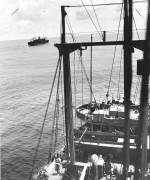
100301424 |
546k |
USS Hunter Liggett (AP-27) underway, date and location unknown.
US National Archives Identifier 205584532, Local Identifier 26-G-1389, US Coast Guard photo # 1389 |
David Upton |
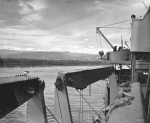
100301429
NA 205584550 |
293k |
USS Hunter Liggett (AP-27) probably Guadalcanal-Tulagi landings, 7-9 August 1942.
US National Archives Identifiers 205584550, Local Identifier 26-G-1341, US Coast Guard photo # 1350,
US National Archives Identifiers 205584535, Local Identifier 26-G-1341, US Coast Guard photo # 1341,
US National Archives Identifiers 205584544, Local Identifier 26-G-1345, US Coast Guard photo # 1345,
US National Archives Identifiers 205584559, Local Identifier 26-G-1346, US Coast Guard photo # 1346,
US National Archives Identifiers 205584556, Local Identifier 26-G-1346, US Coast Guard photo # 1343, |
David Upton |
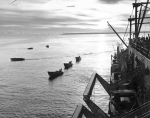
100301425
NA 205584535 |
311k |
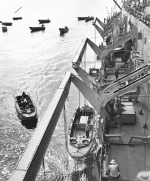
100301426
NA 205584544 |
623k |
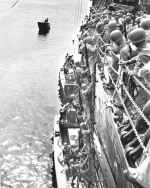
100301427
NA 2055845594 |
541k |
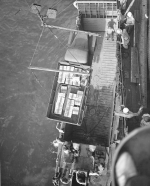
100301428
NA 2055845596 |
479k |

100301430 |
318k |
USS Hunter Liggett (AP-27) in the floating drydock at Wellington, New Zealand, having her hull scraped. 1-2 October 1942.
Photo from Museum Of Wellington, used for educational and non-commercial purpose. |
John Chiquoine |

100301431 |
132k |
USS Hunter Liggett (AP-27) and her boats shift cargo to Koli Point, Guadalcanal, as TG62.4.7, 14 December 1942.
Photo by Frank Scherschel, Life Magazine. Used for educational and non-commercial purpose. |
John Chiquoine |
 USS Hunter Liggett (APA-14) USS Hunter Liggett (APA-14)
|
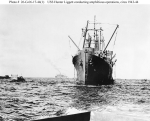 |
109k |
USS Hunter Liggett (APA-14), conducting amphibious operations, circa 1943-44.
US National Archives photo # 26-G-06-17-44(1), from the US Coast Guard Collection in the US National Archives. |
US Naval History and Heritage Command |
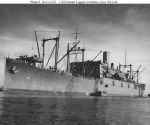 |
87k |
USS Hunter Liggett (APA-14), at anchor circa 1943-45
US National Archives photo # 26-G-3337, from the US Coast Guard Collection in the US National Archives. |
US Naval History and Heritage Command |
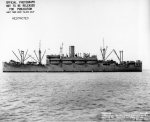
Navy Yard Mare Island photo # 2036 |
95k |
USS Hunter Liggett (APA-14) of San Francisco, 29 March 1944, after receiving alterations at the Mare Island Navy
Yard. The 5"/51 gun aft has been replaced with a 1.1" quad mount. Two of the ship's 4-3"/50 guns are at the forward end of the small poop deck. Note also the multiple
steering wheels on this deck for emergency use.
Navy Yard Mare Island photo #'s 2036, 2039, 2040 courtesy Darryl Baker and US National Archives, RG-19-LCM. Photo # 19-N-66838, courtesy Shipscribe.com. |
Darryl Baker and
Robert Hurst |
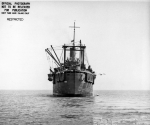
Navy Yard Mare Island photo # 2039 |
79k |
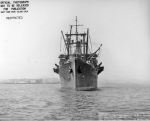
Navy Yard Mare Island photo # 2040 |
83k |
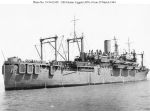
US National Archives, RG-19-LCM. Photo # 19-N-66838 |
98k |
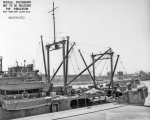 |
97k |
Aft plan view of USS Hunter Liggett (APA-14) at San Francisco, 1 April 1944.
Navy Yard Mare Island photo # 2087. |
Darryl Baker |
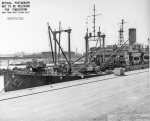 |
94k |
Forward plan view of USS Hunter Liggett (APA-14) at San Francisco, 1 April 1944.
Navy Yard Mare Island photo # 2088. |
Darryl Baker |
 |
60k |
USS Hunter Liggett (APA-14) probably during amphibious training operations in the San Diego area, circa second half of 1944.
US National Archives photo # Photo No. 26-G-1781 a US Coast Guard photo from the Office of the US Coast Guard Historian. |
Mike Green |
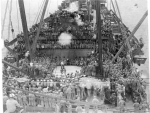 |
155k |
USS Hunter Liggett (APA-14) underway, probably while serving as an amphibious training ship in the San Diego area,, circa
April to December 1944. Note the "Smoker" in progress. |
John Rubin for his father CPhM Seldon L. Rubin USS Hunter Liggett |
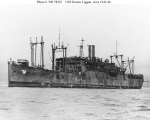 |
70k |
USS Hunter Liggett (APA-14), circa 1945-46. The gun at her bow has been removed, indicating that the view was taken after the end of World War II.
US Navy photo # NH 78567, from the collections of the uS Naval History and Heritage Command . |
uS Naval History and Heritage Command |

100301423 |
171k |
Ex-Hunter Liggett (APA-14) under tow at Long Beach in 1948. Hunter Liggett was under tow from the
National Defense Reserve Fleet, Olympia, WA. to Boston Metals Co., Baltimore, MD. for dismantling. |
David Wright |
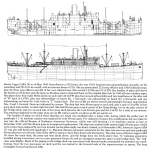 |
569k |
Outboard and inboard profiles of USS Hunter Liggett (APA-14) as of May 1945.
Illustration from "U.S. Amphibious Ships and Craft" by Norman Friedman. |
Robert Hurst |
 |
146k |
Deck plan for USS Hunter Liggett (APA-14) as of May 1945.
Illustration from "U.S. Amphibious Ships and Craft" by Norman Friedman. |
Robert Hurst |
